2018 MERCEDES-BENZ S-CLASS SEDAN warning
[x] Cancel search: warningPage 49 of 562
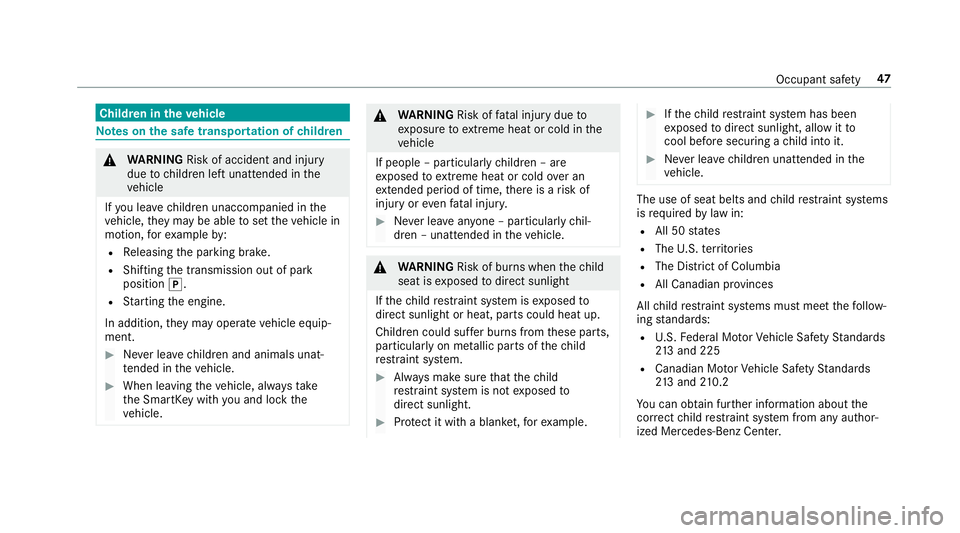
Children in theve hicle
Note s onthe safe transportation of children
&
WARNING Risk of accident and injury
due tochildren left unatte nded inthe
ve hicle
If yo u lea vechildren unaccompanied in the
ve hicle, they may be able toset theve hicle in
motion, forex ample by:
RRe leasing the parking brake.
RShifting the transmission out of park
position j.
RStarting the engine.
In addition, they may operate vehicle equip‐
ment.
#Ne ver lea vechildren and animals unat‐
te nded in theve hicle.
#When leaving theve hicle, alw aysta ke
th e SmartK eywith you and lock the
ve hicle.
&
WARNING Risk offata l injury due to
ex posure toextreme heat or cold in the
ve hicle
If people – particularly children – are
ex posed toextreme heat or cold over an
ex tended pe riod of time, there is a risk of
injury or evenfa ta l injur y.
#Never lea veanyone – pa rticularly chil‐
dren – unatte nded intheve hicle.
&
WARNING Risk of burn s whenthech ild
seat is exposed todirect sunlight
If th ech ild restra int sy stem is exposed to
direct sunlight or heat, parts could heat up.
Children could suf fer burns from these parts,
particularly on me tallic parts of thech ild
re stra int sy stem.
#Alw ays make sure that thech ild
re stra int sy stem is not exposed to
direct sunlight.
#Pr otect it with a blank et,fo rex ample.
#Ifth ech ild restra int sy stem has been
ex posed todirect sunlight, allow it to
cool before securi ng achild into it.
#Ne ver lea vechildren unatte nded inthe
ve hicle.
The use of seat belts and child restra int sy stems
is requ ired bylaw in:
RAll 50 states
RThe U.S. territories
RThe District of Columbia
RAll Canadian pr ovinces
All child restra int sy stems must meet thefo llow‐
ing standards:
RU. S. Federal Mo torVe hicle Saf etySt andards
21 3 and 225
RCanadian Mo torVe hicle Saf etySt andards
21 3 and 210.2
Yo u can obtain fur ther information about the
cor rect child restra int sy stem from any author‐
ized Mercedes-Benz Center.
Occupant saf ety 47
Page 50 of 562
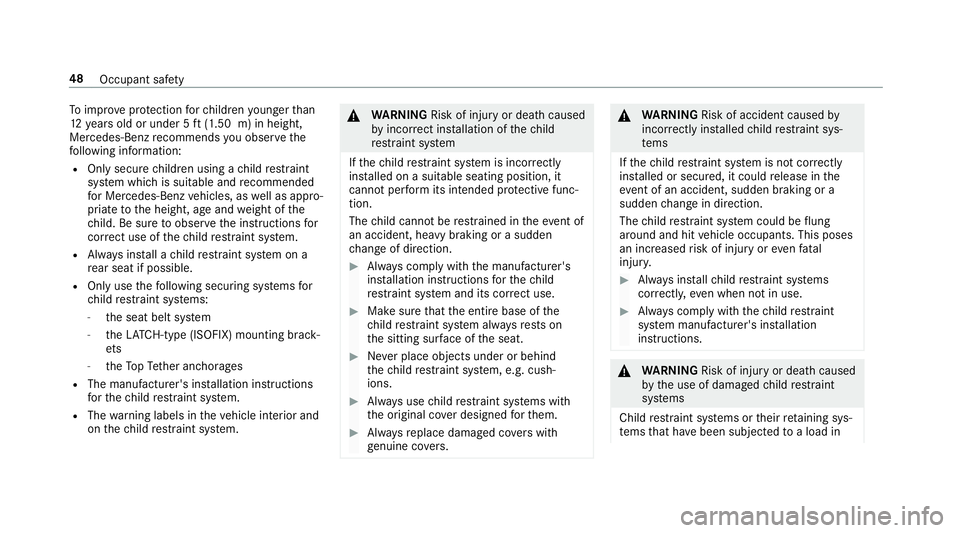
Toimpr oveprotection forch ildren younger than
12 years old or under 5 ft(1.50 m) in height,
Mercedes-Benz recommends you observ eth e
fo llowing information:
ROnly secure children using a child restra int
sy stem which is suitable and recommended
fo r Mercedes-Benz vehicles, as well as appro‐
priate tothe height, age and weight of the
ch ild. Be sure toobser vethe instructions for
cor rect use of thech ild restra int sy stem.
RAlw ays ins tall a child restra int sy stem on a
re ar seat if possible.
ROnly usethefo llowing securing sy stems for
ch ild restra int sy stems:
-th e seat belt sy stem
-th eLA TC H-type (ISOFIX) mounting brack‐
et s
-th eTo pTe ther anchorages
RThe manufacturer's ins tallation instructions
fo rth ech ild restra int sy stem.
RThe warning labels in theve hicle interior and
on thech ild restra int sy stem.
&
WARNING Risk of injury or death caused
by incor rect ins tallation of thech ild
re stra int sy stem
If th ech ild restra int sy stem is incor rectly
ins talled on a suitable seating position, it
cannot per form its intended pr otective func‐
tion.
The child cannot be restra ined in theeve nt of
an accident, heavy braking or a sudden
ch ange of direction.
#Alw ays comply with the manufacturer's
ins tallation instructions forth ech ild
re stra int sy stem and its cor rect use.
#Make surethat the entire base of the
ch ild restra int sy stem alw aysre sts on
th e sitting sur face of the seat.
#Ne ver place objects under or behind
th ech ild restra int sy stem, e.g. cush‐
ions.
#Alw ays use child restra int sy stems with
th e original co ver designed forth em.
#Alw aysre place damaged co vers with
ge nuine co vers.
&
WARNING Risk of accident caused by
incor rectly ins talled child restra int sys‐
te ms
If th ech ild restra int sy stem is not cor rectly
ins talled or secured, it could release in the
ev ent of an accident, sudden braking or a
sudden change in direction.
The child restra int sy stem could be flung
around and hit vehicle occupants. This poses
an increased risk of injury or even fata l
injur y.
#Always ins tallch ild restra int sy stems
cor rectl y,eve n when not in use.
#Alw ays comply with thech ild restra int
sy stem manufacturer's ins tallation
instructions.
& WARNING Risk of injury or death caused
by the use of damaged child restra int
sy stems
Child restra int sy stems or their retaining sys‐
te ms that ha vebeen subjec tedto a load in
48
Occupant saf ety
Page 51 of 562

an accident maythen not be able toper form
th eir intended pr otective function.
The child cannot be restra ined in theeve nt of
an accident, heavy braking or a sudden
ch ange of direction.
#Alw aysre place child restra int sy stems
immediately that ha vebeen damaged or
in vo lved in an accident.
#Ha ve the securing sy stems forth ech ild
re stra int sy stems checked at a qualified
specialist workshop before ins talling a
ch ild restra int sy stem again.
A boos ter seat may be necessary toachie ve
proper seat belt positioning forch ildren over
40 lbs (18 kg) in weight or until they reach a
height where a thre e-point seat belt can be
ins talled proper lywithout a boos ter seat.
Ve hicles with seat belt buckle extenders:
When securing a child in a child restra int sy stem
on a rear seat, observ eth efo llowing no tes:
RMake sure that the seat belt is fastened on
th ech ild restra int sy stem according tothe manufacturer's ins
tallation instructions for
th ech ild restra int sy stem.
RFo rch ild restra int sy stems with a belt clamp:
engage the seat belt tongue into the seat belt
buckle before you tighten the seat belt using
th e belt clamp.
&
WARNING Risk of injury duetothe seat
backrest being reclined toofa r back‐
wa rds
If ach ild restra int sy stem is ins talled and the
seat backrest is reclined toofa r backwards,
th e cushionbag may deploy bymis take inthe
eve nt of an accident.
#When using a child restra int sy stem,
alw ays ensure that the seat is cor rectly
adjus ted and that the seat backrest is
almost vertical.
Ve hicles with a reclining rear seat: When
ins talling a child restra int sy stem, mo vethe
re clining rear seat backrest toan almost upright
position. The reclining rear seat backrest must
re st against thech ild restra int sy stem. Obser ve
th e no tes on the cushionbag (
→page 38). Ve
hicles with a reclining rear seat: Ifyo u
ins tall a child restra int sy stem on there clining
re ar seat, be sure toobser vethech ild restra int
sy stem manufacturer's ins tallation instructions.
The following no tes must be obser ved:
RWhen ins talling a child restra int sy stem on
th e front passenger seat, the information on
ins talling a child restra int sy stem on the front
passenger seat (
→page 53).
RInstructions and saf etyno tes on the auto‐
matic front passenger air bag shutoff
(
→page 41).
RSaf etyno tes on the seat belt (→page 33).
RInformation on the cor rect use of the seat
belt (→page 38).
Occupant saf ety 49
Page 52 of 562
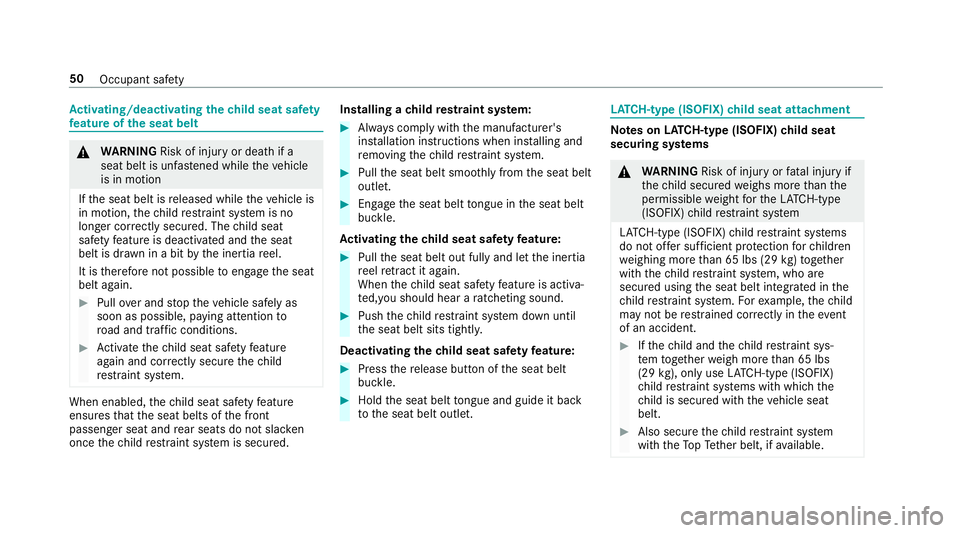
Activating/deactivating the child seat saf ety
fe ature of the seat belt
&
WARNING Risk of injury or death if a
seat belt is unfas tened while theve hicle
is in motion
If th e seat belt is released while theve hicle is
in motion, thech ild restra int sy stem is no
longer cor rectly secure d. Thechild seat
saf etyfe ature is deactivated and the seat
belt is dr awn in a bit bythe inertia reel.
It is therefore not possible toengage the seat
belt again.
#Pull over and stop theve hicle safely as
soon as possible, paying attention to
ro ad and traf fic conditions.
#Ac tivate thech ild seat saf etyfe ature
again and cor rectly secure thech ild
re stra int sy stem.
When enabled, thech ild seat saf etyfe ature
ensures that the seat belts of the front
passenger seat and rear seats do not slac ken
once thech ild restra int sy stem is secured. Installing a
child restra int sy stem:
#Alw ays comply with the manufacturer's
ins tallation instructions when ins talling and
re moving thech ild restra int sy stem.
#Pull the seat belt smoo thly from the seat belt
outlet.
#En gage the seat belt tongue in the seat belt
buckle.
Ac tivating the child seat saf etyfe ature:
#Pull the seat belt out fully and let the inertia
re el retract it again.
When thech ild seat saf etyfe ature is activa‐
te d,you should hear a ratcheting sound.
#Push thech ild restra int sy stem down until
th e seat belt sits tightly.
Deactivating the child seat saf etyfe ature:
#Press there lease button of the seat belt
buckle.
#Hold the seat belt tongue and guide it ba ck
to the seat belt outlet.
LA TC H-type (ISOFIX) child seat attachment
Note s onLATC H-type (ISOFIX) child seat
securing sy stems
&
WARNING Risk of injury orfata l injury if
th ech ild secured weighs more than the
permissible weight forth eLA TC H-type
(ISOFIX) child restra int sy stem
LA TC H-type (ISOFIX) child restra int sy stems
do not of fer suf ficient pr otection forch ildren
we ighing more than 65 lbs (29 kg)to ge ther
with thech ild restra int sy stem, who are
secured using the seat belt integrated in the
ch ild restra int sy stem. Forex ample, thech ild
may not be restra ined cor rectly in theeve nt
of an accident.
#If th ech ild and thech ild restra int sys‐
te m toget her weigh more than 65 lbs
(29 kg),only use LATC H-type (ISOFIX)
ch ild restra int sy stems with which the
ch ild is secured with theve hicle seat
belt.
#Also secure thech ild restra int sy stem
with theTo pTe ther belt, if available.
50
Occupant saf ety
Page 53 of 562
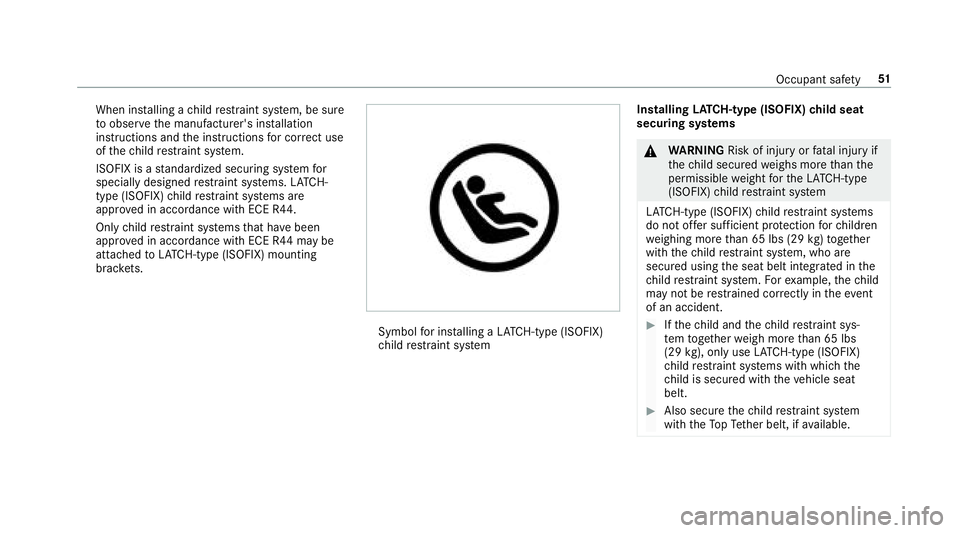
When installing a child restra int sy stem, be sure
to obser vethe manufacturer's ins tallation
instructions and the instructions for cor rect use
of thech ild restra int sy stem.
ISOFIX is a standardized securing sy stem for
specially designed restra int sy stems. LATC H-
type (ISOFIX) child restra int sy stems are
appr oved in accordance with ECE R44.
Only child restra int sy stems that ha vebeen
appr oved in accordance with ECE R44 may be
attached toLATC H-type (ISOFIX) mounting
brac kets.
Symbol for ins talling a LATC H-type (ISOFIX)
ch ild restra int sy stem Installing
LATC H-type (ISOFIX) child seat
securing sy stems
&
WARNING Risk of injury orfata l injury if
th ech ild secured weighs more than the
permissible weight forth eLA TC H-type
(ISOFIX) child restra int sy stem
LA TC H-type (ISOFIX) child restra int sy stems
do not of fer suf ficient pr otection forch ildren
we ighing more than 65 lbs (29 kg)to ge ther
with thech ild restra int sy stem, who are
secured using the seat belt integrated in the
ch ild restra int sy stem. Forex ample, thech ild
may not be restra ined cor rectly in theeve nt
of an accident.
#If th ech ild and thech ild restra int sys‐
te m toget her weigh more than 65 lbs
(29 kg),only use LATC H-type (ISOFIX)
ch ild restra int sy stems with which the
ch ild is secured with theve hicle seat
belt.
#Also secure thech ild restra int sy stem
with theTo pTe ther belt, if available.
Occupant saf ety 51
Page 54 of 562
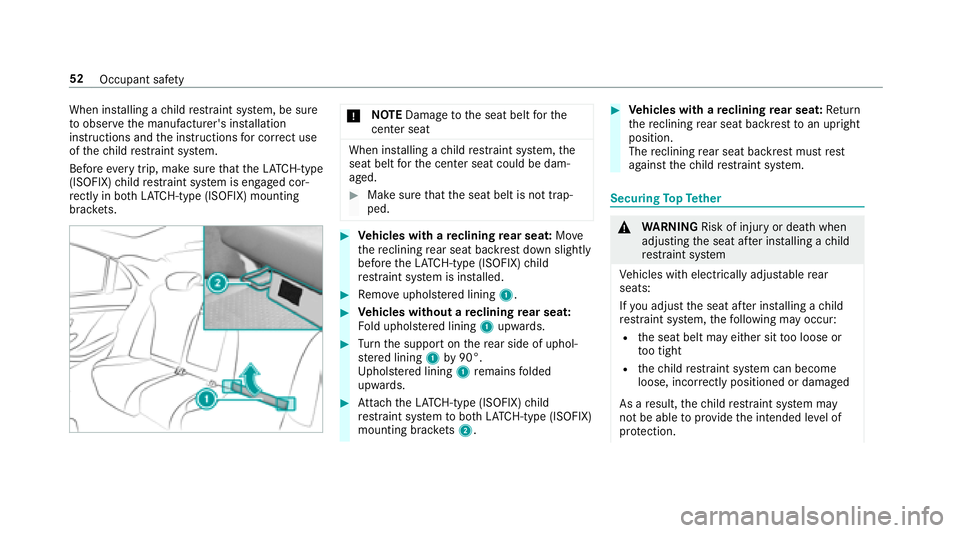
When installing a child restra int sy stem, be sure
to obser vethe manufacturer's ins tallation
instructions and the instructions for cor rect use
of thech ild restra int sy stem.
Before every trip, make sure that theLA TC H-type
(ISOFIX) child restra int sy stem is engaged cor‐
re ctly in bo thLATC H-type (ISOFIX) mounting
brac kets.* NO
TEDama getothe seat belt forth e
center seat
When ins talling a child restra int sy stem, the
seat belt forth e center seat could be dam‐
aged.
#Make sure that the seat belt is not trap‐
ped.
#Ve hicles with a reclining rear seat: Move
th ere clining rear seat backrest down slightly
before theLA TC H-type (ISOFIX) child
re stra int sy stem is ins talled.
#Re mo veupholst ered lining 1.
#Vehicles without a reclining rear seat:
Fo ld uphols tere d lining 1upwards.
#Turn the support on there ar side of uphol‐
st ered lining 1by90°.
Up hols tere d lining 1remains folded
upwards.
#At tach theLA TC H-type (ISOFIX) child
re stra int sy stem toboth LATC H-type (ISOFIX)
mounting brac kets 2.
#Ve hicles with a reclining rear seat: Return
th ere clining rear seat backrest toan upright
position.
The reclining rear seat backrest must rest
against thech ild restra int sy stem.
Securing TopTe ther
&
WARNING Risk of injury or death when
adjusting the seat af ter ins talling a child
re stra int sy stem
Ve hicles with electrically adjus table rear
seats:
If yo u adjust the seat af ter ins talling a child
re stra int sy stem, thefo llowing may occur:
Rth e seat belt may either sit too loose or
to o tight
Rth ech ild restra int sy stem can become
loose, incor rectly positioned or damaged
As a result, thech ild restra int sy stem may
not be able toprov ide the intended le vel of
pr otection.
52
Occupant saf ety
Page 57 of 562

Child safety loc ks
Activating/deactivating the child saf ety lock
fo r the rear doors
&
WARNING Risk of accident and injury
due tochildren left unatte nded inthe
ve hicle
If yo u lea vechildren unaccompanied in the
ve hicle, they may be able toset theve hicle in
motion, forex ample by:
RRe leasing the parking brake.
RShifting the transmission out of park
position j.
RStarting the engine.
In addition, they may operate vehicle equip‐
ment.
#Ne ver lea vechildren and animals unat‐
te nded in theve hicle.
#When leaving theve hicle, alw aysta ke
th e SmartK eywith you and lock the
ve hicle.
&
WARNING Risk offata l injury due to
ex posure toextreme heat or cold in the
ve hicle
If people – particularly children – are
ex posed toextreme heat or cold over an
ex tended pe riod of time, there is a risk of
injury or evenfa ta l injur y.
#Never lea veanyone – pa rticularly chil‐
dren – unatte nded intheve hicle.
&
WARNING Thereis arisk of accident
and injury if you lea vechildren unatte n‐
ded in theve hicle
If ch ildren are tra veling in theve hicle, they
could:
ROpen doo rs,th ereby endangering other
persons or road users.
RGet out of theve hicle and be hit by
oncoming traf fic.
ROpe rate ve hicle equipment and become
trapped, forex ample.
#Alw ays activate thech ild saf etyloc ks
av ailable if children are tra veling in the
ve hicle.
#Ne ver lea vechildren unatte nded inthe
ve hicle.
#When leaving theve hicle, alw aysta ke
th e SmartK eywith you and lock the
ve hicle.
Child saf etyloc ksare available forth ere ar doors
and forth ere ar side wind ows.
The child saf etyloc kon there ar doors secures
each door separatel y.The doors can no longer
be opened from the inside.
Occupant saf ety 55
Page 58 of 562
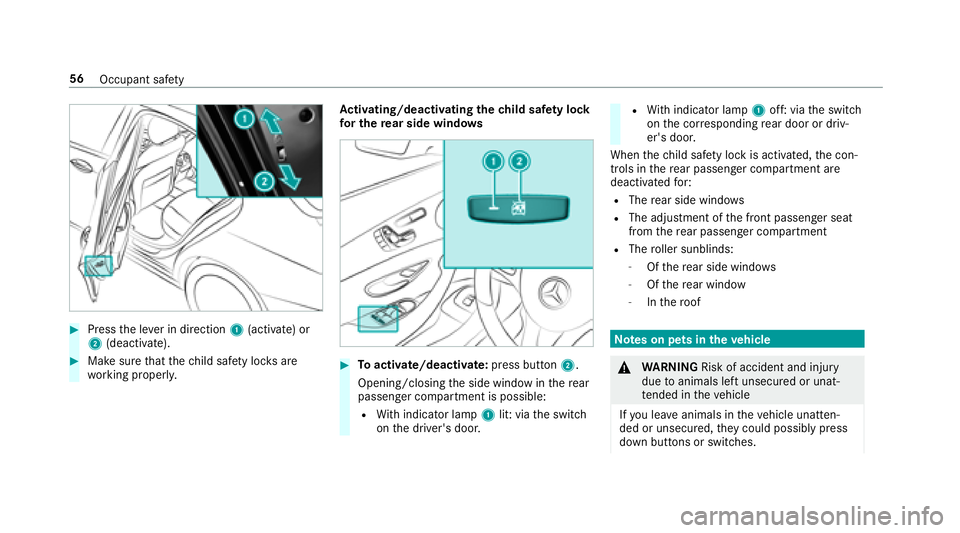
#Pressthe le ver in direction 1(activate) or
2 (deactivate).
#Make sure that thech ild saf etyloc ksare
wo rking properly. Ac
tivating/deactivating the child saf ety lock
fo r the rear side windo ws#Toactivate/deacti vate:press button 2.
Opening/closing the side window in there ar
passenger compartment is possible:
RWi th indicator lamp 1lit: via the switch
on the driver's door.
RWi th indicator lamp 1off: via the switch
on the cor responding rear door or driv‐
er's door.
When thech ild saf etyloc kis activated, the con‐
trols in there ar passenger compartment are
deactivated for:
RThe rear side wind ows
RThe adjustment of the front passenger seat
from there ar passenger compartment
RThe roller sunblinds:
-Of there ar side wind ows
-Ofthere ar wind ow
-Inthero of
Note s on pets in theve hicle
&
WARNING Risk of accident and injury
due toanimals left unsecured or unat‐
te nded in theve hicle
If yo u lea veanimals in theve hicle unatten‐
ded or unsecured, they could possibly press
down buttons or switches.
56 Occupant saf ety